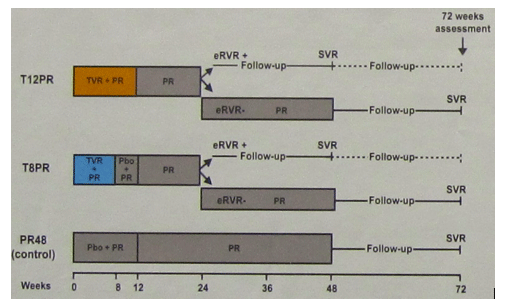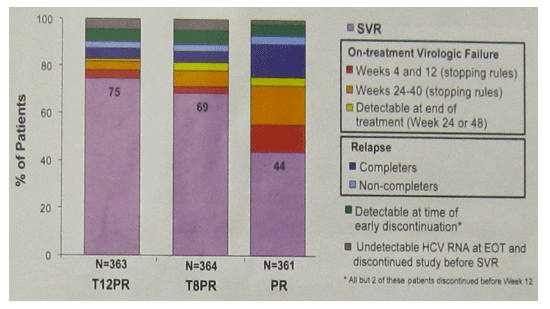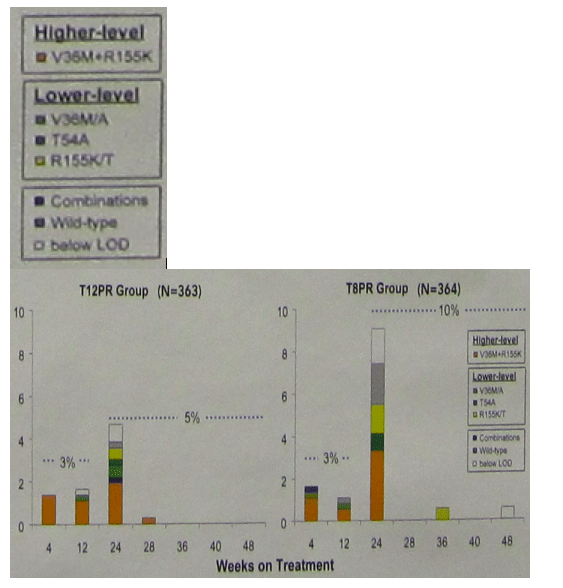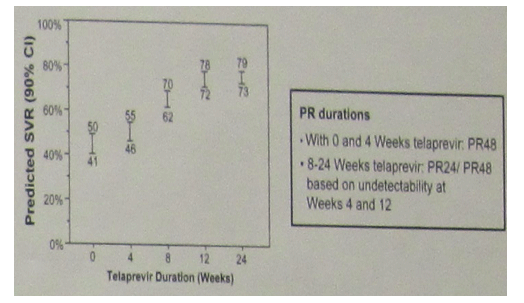 |
 |
 |
| |
Clinical Virology Results from Telaprevir Phase 3 Study ADVANCE
|
| |
| |
Reported by Jules Levin
AASLD Nov 1 2010 Boston
Tara Kieffer, Doug Bartels, James Sullivan, Bambang Adiwijaya, Eileen Zhang, Ann Tigges, Jennifer Dorrian, Joan Spanks, Sandra De Meyer, Gaston Picchio, Natalie Adda, Ann Kwong, and the ADVANCE Study. Vertex, Tibotec Belgium, Tibotec NJ, Corresponding author: tara_kieffer@vrtx.com
AUTHOR CONCLUSIONS
The SVR rates in the T12PR (75%) and T8PR (69%) regimens were significantly higher (p<0.0001) than PR alone (44%); with T12PR being numerically higher than T8PR.
An approximately 5% higher rate of on-treatment virologic failure rate was observed during the PR treatment phase in T8PR compared to T12PR, predominantly associated with lower-level telaprevir resistant variants, suggesting that telaprevir may continue to exert antiviral pressure on wild-type and lower-level resistant variants between weeks 8 and 12, thus reducing subsequent virologic failure rates during the PR treatment phase of patients in the T12PR arm.
Consistent with these clinical results, modeling predicted a telaprevir duration of 12 weeks to be sufficient to eradicate wild-type and the majority of lower-level telaprevir-resistant variants.
The majority of patients who failed treatment with resistant variants no longer had detectable telaprevir-resistant variants at the end of the study (median follow-up time: 45 weeks).
INTRODUCTION
Telaprevir (T, TVR) is a potent inhibitor of the hepatitis C virus (HCV) NS3-4A protease.
TVR in combination with peginterferon alfa-2a (P, Peg-IFN) and ribavirin (R, RBV) demonstrated an increase in sustained viral response (SVR) rates compared to Peg-IFN/RBV in Phase 2 clinical trials in both treatment-naive12 and treatment-experienced3 HCV genotype 1 patients.
ADVANCE was a phase 3 study which evaluated TVR in combination with Peg-IFN alfa-2/RBV in treatment-naïve patients with genotype 1 HCV infection.
METHODS
ADVANCE was a double-blind, randomized, placebo-controlled Phase 3 study which assessed the efficacy and safety of 2 TVR-based regimens (TPR).
Patients in the TVR arms who achieved an eRVR (extended RVR, undetectable HCV RNA at weeks 4 and 12) received a total of 24 weeks of therapy, while those who did not achieve an eRVR received a total of 48 weeks of therapy (Figure 1).
STUDY DESIGN

eRVR = HCV RNA undetectable at week 4 and week 12
(T) TVR = telaprevir 750 mg q8h; Pbo = placebo; (P) Peg-IFN = peginterferon alfa-2a (40 kD) 180 ug/wk; RBV = ribavirin 1,000 or 1,200 mg/day.
------------------------------------------------------
Protocol-defined stopping rules were implemented to prevent continued treatment in patients who did not meet certain response criteria and were unlikely to benefit from treatment.
-- HCV RNA >1000 IU/mL at week 4 or < 2 log10 decrease in HCV RNA at week 12
-- Undetectable HCV RNA at weeks 24, 28, 36, and 40
Plasma HCV RNA levels were measured using Roche Taqman HCV RNA assay version 2.0 (lower limit of quantificatio of 25 IU/mL).
Population sequencing of the NS3-4A region was performed at baseline, during, and after treatment in patients who did not achieve an SVR (limit of detection >1000 IU/mL).
A viral dynamic model was developed from HCV RNA and drug exposure versus time data from a total of 1162 patients who participated in telaprevir phase 2 clinical trials (PRIVE1, PROVE2, PROVE3 and C208 studies) evaluating regimens including peginterferon-alfa, ribavirin and telaprevir. Details of the methods and validation of the model have been published elsewhere4.
RESULTS
ANTIVIRAL ACTIVITY
The SVR rates in the T12PR (75%) and T8PR (69%) regimens were significantly higher (p<0.0001) than PR alone (44%) (Figure 2); with T12PR being numerically higher than T8PR.
Patients who did not achieve an SVR failed treatment due to on-treatment virologic failure, relapse, detectable HCV RNA at the time of early discontinuation (for reasons other than virologic stopping rules), or lost-to-follow-up (undetectable HCV RNA at end of treatment (EOT) but discontinuation before SVR assessment) (Figure 2).
Figure 2: Treatment Outcomes

Overall on-treatment virologic failure was 8% for the T12PR arm and 13% for the T8PR arm (figures 2 and 3).
On-treatment virologic failure during the TVR treatment phase was similar between TVR-treatment arms (3% in both T12PR and T8PR arms).
On-treatment virologic failure during the PR treatment phase was lower in the T12PR arm (5%) compared to the T*PR arm (10%).
SEQUENCE ANALYSIS IN SUBJECTS WITH ON-TREATMENT VIROLOGIC FAILURE
On-treatment virologic failure during the TVR treatment phase (weeks 1-12) was associated with higher-level resistant variants in both TVR-treatment arms (Figure 3).
On-treatment virologic failure during the PR treatment phase (after TVR dosing; weeks 12-48) was associated with a lower frequency of wild-type and lower-level resistant variants in the T12PR arm compared to the T8PR arm, suggesting that TVR may continue to provide antiviral pressure on wild-type and lower-level variants after week 8, through week 12 (Figure 3).
Figure 3: Telaprevir-Resistant Variants Associated with On-Treatment Virologic Failure
Higher-level
V36M+R155K (I think looks like the orange color)
Lower-level
T54A looks like blue
V36M/A looks like light green
Looks like light green = R155K/T
Combinations
White below LOD
Wild-type green

MODELING ANALYSES
The model predicted that a 12-week telaprevir duration would eradicate wild-type and lower-level resistant variants in treatment-naïve patients. Compared to 12 weeks of telaprevir (figure 4), the model predicted that:
-- Shorter (4- or 8-week) telaprevir durations would reduce SVR rates by increasing virologic failure during Peg-IFN/RBV treatment with wild-type or lower-level resistant variants.
-- Longer (24-week) telaprevir durations would, at best, result in a very modest increase in SVR rates.
Figure 4: Model-Predicted SVR Rates According to Duration of Telaprevir Treatment

EVOLUTION of TVR-RESISTANT VARIANTS IN THE ABSENCE OF TREATMENT
Viral populations in patients that did not achieve SVR after telaprevir-containing regimens were monitored by population sequencing after treatment-failure in the absence of drug.
A total of 63% (55 of 88) of patients with resistant variants after treatment failure no longer had resistant variants detected by the end of the study (EOS) (median follow-up 45 weeks) (Figure 5).

References
1McHutchison JG, et al. N Engl J Med 2009;360(18):1827-38. 2Hezode C et al N Engl J Med 2009;360(18):1839-50; 3McHutchison JG et al N Engl J Med 2010;362(14):1292-1303; 4Adiwijaya B et al. Presented at PAGE 2010;Abstr 1767.
|
| |
|
 |
 |
|
|